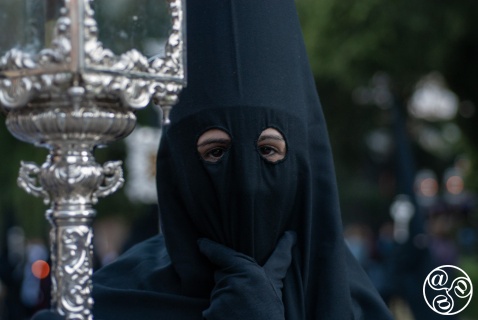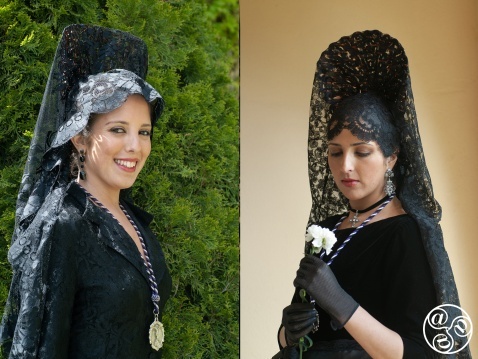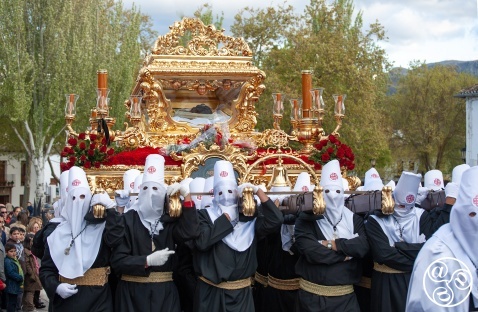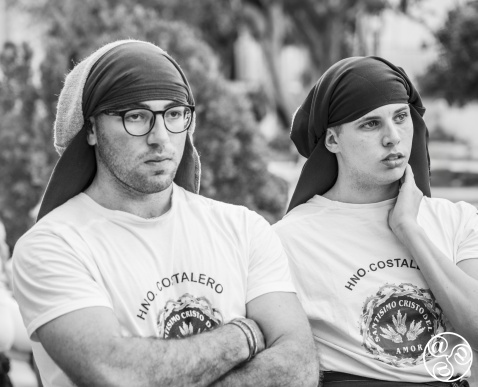
Nazarenos play and important role in the holy week processions © Michelle Chaplow |
|
Semana Santa (Holy Week) processions explained
By Fiona Flores Watson and Chris Chaplow
Guide to Holy Week / Semana Santa in Andalucia
Welcome to Holy Week Explained—your guide to the unforgettable Semana Santa processions in Andalucía. Like a live street theatre, these powerful displays blend art, faith, and emotion. As pasos (floats) showing scenes from Christ’s Passion move through the streets, the air fills with incense and orange blossom. Hooded penitents, somber music, and centuries-old tradition create an atmosphere like no other. This page explores the meaning behind each detail, helping you appreciate the full depth and beauty of this extraordinary event. With a deeper understanding, it becomes a truly moving experience.
Semana Santa (Holy Week) processions throughout Andalucia follow a similar pattern and structure, although they may differ according to the traditions of each city, town and village, or the parish’s “brotherhood” association (hermandad) that organises the procession. Members (hermanos) may join an hermandad due to family tradition, or out of affinity for their local parish church (or both). Holy week processions throughout Andalucia may differ according to the traditions of each city or town. However, there is a general order to most, starting with a large cross, cruz de guía, that is followed by a group of participants bearing lanterns.
What are the processions?
The processions consist of nazarenos (hooded figures) walking in two parallel lines; pasos (floats) with statues of Jesus or the Virgin Mary; and marching brass bands, as well as other elements. The pasos depict scenes of the Passion of Jesus Christ - in other words, the last few days before his death: arrest, sentencing, flagellation, carrying the cross, crucifixion, and resurrection.
In a city each procession goes from its parish church to the cathedral and back again. In a smaller town it goes from the chapel (where the icons reside to the town centre, past the tribuna (official stand) and back. Everything generally runs like clockwork, partly due to the fact that the procession has taken place many times over previous years. But also they are very carefully organised, down to the last detail.
The route of the processions is known as an estación de penitencia, and may include a carrera oficial (official route) used by all processions, a specific route over the last or centre stretch leading to the cathedral, main church or square.
How are the processions organised?
In the larger cities like Seville, Malaga and Granada, where several processions take place over the same few hours, extremely detailed strategic planning, in terms of locations and timing, is needed, to ensure that no two processions will clash. This timetabling is done by the city council together with the council of brotherhoods (made up of senior hermanos). In the case of inclement weather, brotherhoods must each decide whether or not their procession will leave their church; once they are out, if it rains, they shelter in the nearest temple.
The level of organisation in the processions themselves, on the day, is impressive. The several hundred, or even thousand, participants are organised by senior hermanos called diputados de tramo (walking in the middle of the two lines), who control sections of 40-60 nazarenos (see below). Some processions have more than 3,000 participants, and take an hour and half to pass. The person in charge of the entire procession is the diputado mayor.
There is a general order to most processions:
- A large cross, Cruz de Guía (literally, guiding cross) leads the way, borne by a senior member of the brotherhood. He is dressed as a nazareno, wearing a long cape and tunic with pointed hood. The colour of the outfit (most commonly black, white, purple, or green, or a combination thereof) represents the hermandad, whose identifying name and logo you will see on an estandarte (standard or banner, see below), and also sometimes on the hood or cape. The silver badge of the brotherhood hangs around their necks on a plaited coloured cord, and they may wear an esparto and leather belt, or cord, around the waist of their cape or tunic, as well as gloves. Certain details of the outfit, such as the belt, may vary according to their place in the procession (see below). They carry long candles, which are lit at dusk. Some may walk barefoot.
- Other hermanos, along with monaguillos (altar boys and girls, some wearing silver or gold-embroidered tunics called dalmatics, and/or long white tunics with lace sleeves), carry ornate silver candlesticks, staffs, lanterns and long, narrow horns, all prized relics of the brotherhood, and swing ornate silver censers dispensing clouds of incense. The estandarte (standard or banner), a colourful embroidered flag bearing the hermandad’s insignia or a religious image, will be carried by a hooded nazareno. There may be several standards in a processions, including one bearing the letters SPQR. A nazareno will also carry the hermandad’s book of rules.
- A group of young monaguillos, who wear a mini version of the older ones’ white tunics, together with their mothers who keep a watchful eye on them.
- A group of older nazarenos in two parallel lines – walking in pairs, effectively - with lanterns or candles. The most senior is the hermano mayor, followed by the diputado mayor. The closer to the paso an hermano’s place the procession, the more senior he (or she) is. That is to say, the order of importance (measured by longevity) of the hermanos in a procession can be marked by their proximity to the paso.
- A line of senior police officers, from the policia local and nacional and Guardia Civil invited to represent their organisations (in some cases).
- A group of civic dignitaries, sometimes the mayor of a small town and senior council members and civil servants (in some cases).
- Manolas are the ladies in mourning dress who wear black mantillas (long lace veils, also worn at weddings), arranged over a black hair comb, a formal black dress (with hemline below the knee), often with crucifix necklace, and black gloves. They often carry black rosary beads. It is said the origin of the Manolas is from the early 19th century, when women were not allowed to be nazarenos. In order to ensure their participation in the processions, they dressed as respectful mourners – this way, they could not be denied. Manolas only appear in processions (and in the crowds) on Thursday, Friday and Saturday. Although it sounds like a sober outfit, Andalucian manolas are often quite glamorous.
Pasos
The main focus of attention, and adoration, is the pasos (floats) - usually two - with their respective images of Christ and the Virgin Mary, sometimes with accompanying figures (Pontius Pilate, other Romans, Herod, disciples, even horses). These are works of art created by master sculptors, which may be hundreds of years old, and are intricately decorated – the statues are clothed, helmets are plumed, and the edge of the float is decorated with fresh flowers. The entire paso, with figures and often canopy, is generally around two metres tall, and weighs around 1,000-2,000 kilos (1-2 metric tonnes).
To the outsider, all of these floats might look similar. To the insider, however, nothing could be further from the truth. Each image of Christ and the Virgin is unique and has a special title that points to the legend surrounding that particular version of the figure.
First paso: Jesus Christ
The first float is usually a Christ figure, carved from wood, painted and robed in real clothes. Depending on the day of the processions, it will be a depiction of Christ at one stage of the crucifixion story, sometimes with allegorical supporting characters or objects. For example, Christ in the Garden of Gethsemane, Christ being arrested, Christ being whipped, Christ being sentenced to death by crucifixion, Christ carrying the cross, Christ being crowned with thorns, Christ on the cross (Viernes Santo, Good Friday), Christ’s body reposed, or simply the shroud. Other supporting characters may appear, such as Pontius Pilate, creating a tableau scene. This is called a misterio. The float may also feature vegetation and will be richly decorated with fresh flowers around the edge, as well as lanterns with candles which are lit after dark.
These are some popular names for Jesus figures; most are prefaced by Nuestro Padre (Our Father) or Nuestro Señor (Our Lord)
- Nuestro Padre Jesus el Cautivo - Our Father Christ the Captive
- Señor de Sevilla - Lord of Seville
- Cristo del Gran Poder - Christ of the Great Power
- Cristo de Pasión - Christ of the Passion
- Cristo de la Expiración el Viernes Santo - Christ of the Holy Friday Expiration
- Gitano del Polvorín - Gypsy of the Gunpowder
Costaleros
The massive, heavy floats, often weighing more than a ton, are carried on the shoulders, or necks, of around 30-40 male members of the hermandad, called costaleros (costal = sack, so literally “sack men”). They carry this weight (in shifts) for up to 12 hours.
There are two fundamental styles. In Seville, the costaleros are underneath the paso, carrying its weight on their necks. They are hidden by a curtain so they can’t be seen (or, indeed, see). They wear a head covering made of sacking/hessian and cotton over their shoulders and onto their backs, with a padded part on the neck.
The figure of the Virgin or Jesus appears to be walking, as the float rocks from side to side, the palio swinging its fringed edge, with the slow, measured steps of the costaleros.
They change shifts a few times every hour, appearing out from under the curtain when the paso has stopped, so you may see costaleros with the headdresses on around the streets, taking a break. They are usually strong, muscly men, not overly tall. Some wear a corset to support their back.
In other cities, such as Malaga and Granada, (and the villages in these provinces) the costaleros support poles attached to the paso, extending forward and backward, so that some are in front and some behind. This style provides an opportunity for greater numbers of costaleros to share the load. The dress is usually a men’s mourning outfit - black (or very dark grey or blue) suit and tie with white shirt.
It is a particular honour to carry a float, and some will even do so barefoot or blindfolded as a sign of extreme penitence. The costaleros practice in the weeks leading up to Semana Santa, marching around the town with the canasta (wooden float base), weighted down with concrete blocks.
The capataz plays an essential role, giving careful directions for when to turn left or right, slow and speed up the pace, as well as shouting encouragement. He and other hermanos watch out for the corners of the float, especially on tight manoeuvres (think of all the narrow streets in these medieval towns and cities), as well as the headroom under arches, overhanging balconies, cables and trees. The entry and exit to and from their own parish churches can be tricky too, with low Gothic arches. The faithful onlookers often applaud when one of these obstacles has been successfully overcome.
The speed of the float controls the speed of the procession. When the capataz wants to tell the costaleros to get ready, he rings the ceremonial llamador (bell or hammer) on the back of the float. Two or three rings or taps signify ‘get ready’; five seconds later, another ring or tap to lift the float up onto their shoulders, another ring or tap to start moving.
- There may be a few nazarenos walking close to the paso, wearing the headdress without the cone insert, so that the empty headdress lies on their back. They are organisers who need to be agile to check progress and advise parts of the procession to speed up or slow down to avoid gaps forming.
- Then comes the marching brass band, apart from the silent hermandades (for example, in the Madruga on Thursday night in Seville). The band plays a wide range of tunes to suit the moment, generally mournful and wailing when accompanying Jesus. At some points, there are only rhythmical drumbeats, to mark the pace of the paso’s stately progress. It may be the hermandad’s own band, if it is a large one, or an invited band from another hermandad or another town. The return to the home church or chapel of the processions is often acompanied by a triumphant tune. The sucessful exit (and often return) through the chapel's threshold is often acompanied by the band playing the Spanish national anthem.
- There may be a group of penitentes, barefoot or blindfolded members who have volunteered to perform a penance, such as carrying a wooden cross.
- More nazarenos, wearing their capes and capirotes (cone-shaped hoods).
Palm Sunday fills the streets with incense and tradition—immersive traditions © Michelle Chaplow
Second paso: the Virgin Mary
The second float is the Virgin Mary, sometimes cradling Jesus. The Virgin’s velvet manta (cape) and palio (pillared canopy) are made by highly skilled artisan embroiderers, often using real silver or gold thread. At the front of the palio, you may see the insignia of the hermandad.
Confusingly the Virgin Mary has hundreds of different titles, each representing a different role from her life as recorded in the Bible. Here are some typical names, usually prefaced by Nuestra Señora (Our Lady), or some variation thereof.
- Virgen del Rocio - Virgin of the Dew
- Virgen de la Macarena
- Virgen de la Esperanza - Virgin of Hope
- Virgen de Dolores Coronado - Virgin of Crowned Pains
- Virgen de la Victoria - Virgin of the Victory
- Virgen de la Salud – Virgin of health (meaning; caring for the sick)
The float may be illuminated with rows of candles after dark, in front of the Virgin. A member with a long-lit taper and pole, or stepladder, is charged with lighting the candles at dusk, and relighting them as necessary, for example in an open, breezy area such as when crossing a bridge. On a windy night he will be kept busy.
- The second brass band usually follows the second float, and plays faster and more upbeat music.
- More nazarenos may end the formal part of the procession.
- Following the last section of the the procession there may be family members of those in the official part or anyone else who wants to join in.
- At the very and of the procession, there may be a police vehicle to offer security to the back of the procession.
Tips for Following the Processions
To find out when each procession will be leaving its church and what its route will be, there are various sources of information which carry information on all the town or city's processions.
Particularly the weekend before Easter, many local papers will publish a guide for the coming week; also check the tourist office, which may also offer guides. Even though these guides are in Spanish, they are usually in the form of easy-to-decipher timetables, so that even non-Spanish speakers can to understand them. They will include the route and at what exact time the procession is expected to leave its church, pass each point, arrive at its destination, and (in many cases) return to its church again. In larger cities you will also find full guides to the colours of each hermandad, so you can identify them more easily, as well as a short history and even information about the statues.
To get the full experience of the most sacred moments of Holy Week in any Andalucian town, you need to follow some of the late night processions and experience a soulful saeta.
Semana Santa dates
Semand Santa dates for the next few years are in the info box on our Semana Santa home page
Guide to Holy Week / Semana Santa in Andalucia




